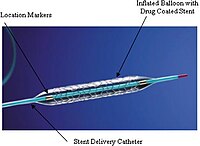
Photo from wikipedia
Coronary artery bypass graft (CABG) surgery remains one of the most important therapeutic options in patients with coronary artery disease. With the increasing significance held by percutaneous coronary intervention (PCI)… Click to show full abstract
Coronary artery bypass graft (CABG) surgery remains one of the most important therapeutic options in patients with coronary artery disease. With the increasing significance held by percutaneous coronary intervention (PCI) in the everyday life of cardiologists, one tends to forget that, in stable patients, coronary artery surgery maintains an advantage over PCI in patients with multivessel disease, and particularly for such patients as those with diabetes. From a psychological standpoint, however, many CABG patients are likely to consider that surgery, because of its more ‘aggressive’ nature, is a more definitive cure of their disease than is PCI (or medical treatment alone) and they may be less prone to take or keep measures that will control the evolution of the atherosclerotic disease, such as lifestyle modifications or long-term adherence to secondary prevention medications. It is to the credit of Zafrir et al. to have addressed this often-neglected issue, by analysing the possible impact of inadequate lipid control after CABG on long-term survival. They performed a retrospective analysis in a single-centre cohort of 1230 patients in whom lipid measurements were available after CABG. After adjusting for potential confounders, they found that patients with low-density lipoprotein cholesterol (LDL-C) levels> 100mg/dl had twice the risk of long-term mortality compared to those with LDL-C levels achieving the recommended target (<70mg/dl), while those with LDL-C from 70–100mg/dl had their risk increased by one-third. Other lipid parameters such as high-density lipoprotein cholesterol (HDL-C or triglyceride levels, were also correlated with long-term mortality. The study is not free from methodological limitations; in particular, the authors used the last lipid values available, and do not describe whether the time from surgery to last lipid measurement was similar for all three categories of LDL-C. Indeed, an imbalance between these times might have major consequences on the association between LDL-C control and outcomes: supposing LDL-C control became less appropriate over time, a not unreasonable assumption, it would mean that patients with inadequate LDL-C control would have survived longer before the starting point of the analysis, compared with those with adequate LDL-C control; it would therefore not be surprising that the survival time after the starting point of the analysis would be shorter (i.e. a higher mortality after the starting point of the analysis, but a possibly identical or longer survival since CABG). In other words, Zafrir and colleagues do not provide proof that achieving the target LDL-C levels will improve survival; but their study is important as it rings an alarm bell for the comprehensive approach we should have in post-CABG patients, as with any other coronary artery disease (CAD) patients. In their population, only a minority of CABG patients (44%) had LDL-C levels within the recommended target, while 21.5% had LDL-C levels over 100mg/dl. We have no idea, however, whether these figures greatly differed from other cohorts of CAD patients followed at the same centre. In other populations, it has been shown that CABG was associated with poorer lipid control, compared with other presentations of CAD, and that poor lipid control was also associated with higher C-reactive protein (CRP) levels. Lipid control can be poorer after CABG because of less adequate prescription of lipid-lowering medication, particularly high-dose statins. In our experience from the French registry of Acute ST-elevation and non-ST elevation Myocardial Infarction (FAST-MI) registries, as in others, patients hospitalised for an acute
Journal Title: European Journal of Preventive Cardiology
Year Published: 2019
Link to full text (if available)
Share on Social Media: Sign Up to like & get
recommendations!